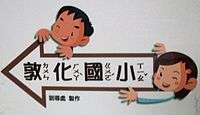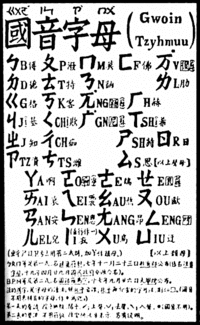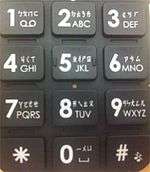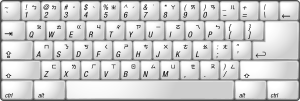Bopomofo
| Mandarin Phonetic Symbols | |
|---|---|
|
百科全書 (encyclopedia) in Zhuyin Fuhao. | |
| Type | |
| Creator |
Commission on the Unification of Pronunciation Introduced by the Gov't of the ROC |
Time period |
1918 to 1958 in China; 1945 to the present in Taiwan |
Parent systems |
Oracle Bone Script
|
Child systems | Taiwanese Phonetic Symbols, Suzhou Phonetic Symbols, Hmu Phonetic Symbols |
Sister systems | Simplified Chinese, Kanji, Hanja, Chữ Nôm, Khitan script |
| Direction | Left-to-right |
| ISO 15924 |
Bopo, 285 |
Unicode alias | Bopomofo |
| |
| Mandarin Phonetic Symbol | |||||||||||||||||||||||||||||
| Traditional Chinese | 注音符號 | ||||||||||||||||||||||||||||
|---|---|---|---|---|---|---|---|---|---|---|---|---|---|---|---|---|---|---|---|---|---|---|---|---|---|---|---|---|---|
| Simplified Chinese | 注音符号 | ||||||||||||||||||||||||||||
| |||||||||||||||||||||||||||||
| Chinese romanisation |
|---|
| Mandarin |
| Wu |
|
|
| Yue |
| Southern Min |
| Eastern Min |
| Northern Min |
| Pu-Xian Min |
| Hainanese |
| Hakka |
| Gan |
| See also |
|
Egyptian hieroglyphs 32 c. BCE
|
Zhuyin fuhao, Zhuyin or Bopomofo (pinyin: bōpōmōfō, Mandarin IPA: [pu̯ópʰu̯ómu̯ófu̯ó]) is a system of phonetic notation for the transcription of spoken Chinese, particularly the Mandarin dialect. The first two are traditional terms, whereas Bopomofo is the colloquial term, also used by the ISO and Unicode. Consisting of 37 characters and four tone marks, it transcribes all possible sounds in Mandarin. Zhuyin was introduced in China by the Republican Government in the 1910s and used alongside the Wade-Giles system, which used a modified Latin alphabet. The Wade system was replaced by Hanyu Pinyin in 1958 by the Government of the People's Republic of China,[1] and at the International Organization for Standardization (ISO) in 1982.[2] Although Taiwan officially abandoned Wade-Giles in 2009, Bopomofo is still the official phonetic notation system of the country and remains widely used as an educational tool and electronic input method in Taiwan.
Name
The informal name "Bopomofo" is derived from the first four syllables in the conventional ordering of available syllables in Mandarin Chinese. The four Bopomofo characters (ㄅㄆㄇㄈ) that correspond to these syllables are usually placed first in a list of these characters. The same sequence is sometimes used by other speakers of Chinese to refer to other phonetic systems.
The original formal name of the system was Guóyīn Zìmǔ (traditional 國音字母, simplified 国音字母, lit. "Phonetic Alphabet of the National Language") and Zhùyīn Zìmǔ (traditional 註音字母, simplified 注音字母, lit. "Phonetic Alphabet" or "Annotated Phonetic Letters").[3] It was later renamed Zhùyīn Fúhào (traditional 注音符號, simplified 注音符号), meaning "phonetic symbols".
In official documents, Zhuyin is occasionally called "Mandarin Phonetic Symbols I" (國語注音符號第一式), abbreviated as "MPS I" (注音一式).
In English translations, the system is often also called either Chu-yin or the Mandarin Phonetic Symbols.[3][4] A romanized phonetic system was released in 1984 as Mandarin Phonetic Symbols II (MPS II).
History
The Commission on the Unification of Pronunciation, led by Wu Zhihui from 1912 to 1913, created a system called Zhuyin Zimu,[3] which was based on Zhang Binglin's shorthand. A draft was released on July 11, 1913, by the Republic of China National Ministry of Education, but it was not officially proclaimed until November 23, 1928.[3] It was later renamed first Guoyin Zimu and then, in April 1930, Zhuyin Fuhao. The last renaming addressed fears that the alphabetic system might independently replace Chinese characters.[5]
Modern use

Zhuyin remains the predominant phonetic system in teaching reading and writing in elementary school in Taiwan. It is also one of the most popular ways to enter Chinese characters into computers and to look up characters in a dictionary in Taiwan.
In elementary school, particularly in the lower years, Chinese characters in textbooks are often annotated with Zhuyin as ruby characters as an aid to learning. Additionally, one children's newspaper in Taiwan, the Mandarin Daily News annotates all articles with Zhuyin ruby characters.
In teaching Mandarin, Taiwan institutions and some overseas communities still use Zhuyin as a learning tool.
Etymology

The Zhuyin characters were created by Zhang Binglin, and taken mainly from "regularised" forms of ancient Chinese characters, the modern readings of which contain the sound that each letter represents. It is to be noted that the first consonants are articulated from the front of the mouth to the back, /b/, /p/, /m/, /f/, /d/, /t/, /n/, /l/ etc.
| Consonants | |||||
|---|---|---|---|---|---|
| Zhuyin | Origin | IPA | Pinyin | WG | Example |
| ㄅ | From 勹, the ancient form and current top portion of 包 bāo | p | b | p | 八 (ㄅㄚ, bā) |
| ㄆ | From 攵, the combining form of 攴 pū | pʰ | p | p' | 杷 (ㄆㄚˊ, pá) |
| ㄇ | From 冂, the archaic character and current radical 冖 mì | m | m | m | 馬 (ㄇㄚˇ, mǎ) |
| ㄈ | From 匚 fāng | f | f | f | 法 (ㄈㄚˇ, fǎ) |
| ㄉ | From 𠚣, archaic form of 刀 dāo. Compare the bamboo form |
t | d | t | 地 (ㄉㄧˋ, dì) |
| ㄊ | From 𠫓 tū, upside-down form of 子 zǐ ( |
tʰ | t | t' | 提 (ㄊㄧˊ, tí) |
| ㄋ | From |
n | n | n | 你 (ㄋㄧˇ, nǐ) |
| ㄌ | From 𠠲, archaic form of 力 lì | l | l | l | 利 (ㄌㄧˋ, lì) |
| ㄍ | From the obsolete character 巜 guì/kuài "river" | k | g | k | 告 (ㄍㄠˋ, gào) |
| ㄎ | From the archaic character 丂 kǎo | kʰ | k | k' | 考 (ㄎㄠˇ, kǎo) |
| ㄏ | From the archaic character and current radical 冂 hǎn | x | h | h | 好 (ㄏㄠˇ, hǎo) |
| ㄐ | From the archaic character 丩 jiū | ʨ | j | ch | 叫 (ㄐㄧㄠˋ, jiào) |
| ㄑ | From the archaic character 𡿨 quǎn, graphic root of the character 巛 chuān (modern 川) | ʨʰ | q | ch' | 巧 (ㄑㄧㄠˇ, qiǎo) |
| ㄒ | From 包, an ancient form of 下 xià. | ɕ | x | hs | 小 (ㄒㄧㄠˇ, xiǎo) |
| ㄓ | From |
ʈʂ | zh | ch | 主 (ㄓㄨˇ, zhǔ) |
| ㄔ | From the character and radical 彳 chì | ʈʂʰ | ch | ch' | 出 (ㄔㄨ, chū) |
| ㄕ | From the character 尸 shī | ʂ | sh | sh | 束 (ㄕㄨˋ, shù) |
| ㄖ | Modified from the seal script form of 日 rì | ɻ | r | j | 入 (ㄖㄨˋ, rù) |
| ㄗ | From the archaic character and current radical 卩 jié, dialectically zié | ts | z | ts | 在 (ㄗㄞˋ, zài) |
| ㄘ | From 𠀁, archaic form of 七 qī, dialectically cī. Compare semi-cursive form |
tsʰ | c | ts' | 才 (ㄘㄞˊ, cái) |
| ㄙ | From the archaic character 厶 sī, which was later replaced by its compound 私 sī. | s | s | s | 塞 (ㄙㄞ, sāi) |
| Rhymes & Medials | |||||
| Zhuyin | Origin | IPA | Pinyin | WG | Example |
| ㄚ | From 丫 yā | a | a | a | 大 (ㄉㄚˋ, dà) |
| ㄛ | From the obsolete character 𠀀 hē, inhalation, the reverse of 丂 kǎo, which is preserved as a phonetic in the compound 可 kě.[7] | o | o | o | 多 (ㄉㄨㄛ, duō) |
| ㄜ | Derived from its allophone in Standard Chinese, ㄛ o | ɤ | e | o/ê | 得 (ㄉㄜˊ, dé) |
| ㄝ | From 也 yě. Compare the Warring States bamboo form |
e | ê | eh | 爹 (ㄉㄧㄝ, diē) |
| ㄞ | From 𠀅 hài, archaic form of 亥. | æi | ai | ai | 晒 (ㄕㄞˋ, shài) |
| ㄟ | From 乁 yí, an obsolete character meaning 移 yí "to move". | ei | ei | ei | 誰 (ㄕㄟˊ, shéi) |
| ㄠ | From 幺 yāo | ɑu | ao | ao | 少 (ㄕㄠˇ, shǎo) |
| ㄡ | From 又 yòu | ou | ou | ou | 收 (ㄕㄡ, shōu) |
| ㄢ | From the archaic character 𢎘 hàn "to bloom", preserved as a phonetic in the compound 犯 fàn | æn | an | an | 山 (ㄕㄢ, shān) |
| ㄣ | From 𠃉, archaic variant of 鳦 yǐ or 乚 yà[8] (乚 is yǐn according to other sources[9]) | ən | en | ên | 申 (ㄕㄣ, shēn) |
| ㄤ | From 尢 wāng | ɑŋ | ang | ang | 上 (ㄕㄤˋ, shàng) |
| ㄥ | From 𠃋, archaic form of 肱 gōng[10] | əŋ | eng | êng | 生 (ㄕㄥ, shēng) |
| ㄦ | From 儿, the bottom portion of 兒 ér used as a cursive and simplified form | ɐɚ | er | êrh | 而 (ㄦˊ, ér) |
| ㄧ | From 刀 yī | i | i/y | i | 逆 (ㄋㄧˋ, nì) |
| ㄨ | From 包, ancient form of 五 wǔ. Compare the transitory form 𠄡. | u | u/w | u/w | 努 (ㄋㄨˇ, nǔ) |
| ㄩ | From the ancient character 凵 qū, which remains as a radical | y | ü/yu | ü/yü | 女 (ㄋㄩˇ, nǚ) |
| ㄭ |
From the character 刀. It represents the minimal vowel of ㄓ, ㄔ, ㄕ, ㄖ, ㄗ, ㄘ, ㄙ, though it is not used after them in transcription.[11] | ɻ̩ / ɹ̩ | -i | ih/û | 資 (ㄗ, zī); 知 (ㄓ, zhī); 死 (ㄙˇ, sǐ) |
Writing
Stroke order
Zhuyin is written in the same stroke order rule as Chinese characters. Note that ㄖ is written with three strokes, unlike the character from which it is derived (日, Hanyu Pinyin: rì), which has four strokes.
Tonal marks
| Tone | Zhuyin | Pinyin |
|---|---|---|
| 1 | none | ¯ |
| 2 | ˊ | ˊ |
| 3 | ˇ | ˇ |
| 4 | ˋ | ˋ |
| 5 | ˙ | none |
The tone marks used in Zhuyin for the second, third, and fourth tones are the same as the ones used in Hanyu Pinyin. In Zhuyin, no marker is used for the first tone and a dot denotes the neutral tone, whereas in Pinyin, a dash (¯) represents the first tone and no marker is used for the neutral tone.
Unlike Hanyu Pinyin, Zhuyin aligns well with the hanzi characters in books whose texts are printed vertically, making Zhuyin better suited for annotating the pronunciation of vertically oriented Chinese text.
Zhuyin, when used in conjunction with Chinese characters, are typically placed to the right of the Chinese character vertically or to the top of the Chinese character in a horizontal print (see Ruby character).
Below is an example for the word "bottle" (pinyin: píngzi):
|
or |
|
Comparison
Pinyin
Zhuyin and pinyin are based on the same Mandarin pronunciations, hence there is a one-to-one correspondence between the two systems:
| Rhyme | |||||||||||||||
|---|---|---|---|---|---|---|---|---|---|---|---|---|---|---|---|
| ㄚ | ㄛ | ㄜ | ㄝ | ㄞ | ㄟ | ㄠ | ㄡ | ㄢ | ㄣ | ㄤ | ㄥ | ㄦ | |||
| Medial | [ɨ] (ㄭ) 1 -i |
[a] ㄚ a -a |
[u̯o] ㄛ 3 -o 3 |
[ɤ] ㄜ e -e |
[ai̯] ㄞ ai -ai |
[ei̯] ㄟ ei -ei |
[au̯] ㄠ ao -ao |
[ou̯] ㄡ ou -ou |
[an] ㄢ an -an |
[ən] ㄣ en -en |
[aŋ] ㄤ ang -ang |
[əŋ] ㄥ eng -eng |
[aɚ] ㄦ er | ||
| 丨 | [i] 丨 yi -i |
[i̯a] 丨ㄚ ya -ia |
[i̯e] 丨ㄝ ye -ie |
[i̯au̯] 丨ㄠ yao -iao |
[i̯ou̯] 丨ㄡ you -iu |
[i̯ɛn] 丨ㄢ yan -ian |
[in] 丨ㄣ yin -in |
[i̯aŋ] 丨ㄤ yang -iang |
[iŋ] 丨ㄥ ying -ing |
||||||
| ㄨ | [u] ㄨ wu -u |
[u̯a] ㄨㄚ wa -ua |
[u̯o] ㄨㄛ 3 wo -uo 3 |
[u̯ai̯] ㄨㄞ wai -uai |
[u̯ei̯] ㄨㄟ wei -ui |
[u̯an] ㄨㄢ wan -uan |
[u̯ən] ㄨㄣ wen -un |
[u̯aŋ] ㄨㄤ wang -uang |
[u̯əŋ], [ʊŋ] ㄨㄥ weng -ong 4 |
||||||
| ㄩ | [y] ㄩ yu -ü 2 |
[y̯e] ㄩㄝ yue -üe 2 |
[y̯ɛn] ㄩㄢ yuan -üan 2 |
[yn] ㄩㄣ yun -ün 2 |
[i̯ʊŋ] ㄩㄥ yong -iong |
||||||||||
1 Not written.
2 ü is written as u after j, q, x, or y.
3 ㄨㄛ/-uo are written as ㄛ/-o after b, p, m, or f.
4 weng is pronounced [ʊŋ] (written as ong) when it follows an initial.
Chart
| IPA | a | ɔ | ɛ | ɤ | ai | ei | au | ou | an | ən | aŋ | əŋ | ʊŋ | aɚ |
|---|---|---|---|---|---|---|---|---|---|---|---|---|---|---|
| Pinyin | a | o | ê | e | ai | ei | ao | ou | an | en | ang | eng | ong | er |
| Tongyong Pinyin | a | o | e | e | ai | ei | ao | ou | an | en | ang | eng | ong | er |
| Wade–Giles | a | o | eh | ê/o | ai | ei | ao | ou | an | ên | ang | êng | ung | êrh |
| Zhuyin | ㄚ | ㄛ | ㄝ | ㄜ | ㄞ | ㄟ | ㄠ | ㄡ | ㄢ | ㄣ | ㄤ | ㄥ | ㄨㄥ | ㄦ |
| example | 阿 | 哦 | 呗 | 俄 | 艾 | 黑 | 凹 | 偶 | 安 | 恩 | 昂 | 冷 | 中 | 二 |
| IPA | i | ie | iou | iɛn | in | iŋ | iʊŋ | u | uo | uei | uən | uəŋ | y | ye | yɛn | yn |
|---|---|---|---|---|---|---|---|---|---|---|---|---|---|---|---|---|
| Pinyin | yi | ye | you | yan | yin | ying | yong | wu | wo/o | wei | wen | weng | yu | yue | yuan | yun |
| Tongyong Pinyin | yi | ye | you | yan | yin | ying | yong | wu | wo/o | wei | wun | wong | yu | yue | yuan | yun |
| Wade–Giles | i/yi | yeh | yu | yen | yin | ying | yung | wu | wo/o | wei | wên | wêng | yü | yüeh | yüan | yün |
| Zhuyin | ㄧ | ㄧㄝ | ㄧㄡ | ㄧㄢ | ㄧㄣ | ㄧㄥ | ㄩㄥ | ㄨ | ㄨㄛ/ㄛ | ㄨㄟ | ㄨㄣ | ㄨㄥ | ㄩ | ㄩㄝ | ㄩㄢ | ㄩㄣ |
| example | 一 | 也 | 又 | 言 | 音 | 英 | 用 | 五 | 我 | 位 | 文 | 翁 | 玉 | 月 | 元 | 云 |
| IPA | p | pʰ | m | fəŋ | tiou | tuei | tuən | tʰɤ | ny | ly | kɤɚ | kʰɤ | xɤ |
|---|---|---|---|---|---|---|---|---|---|---|---|---|---|
| Pinyin | b | p | m | feng | diu | dui | dun | te | nü | lü | ger | ke | he |
| Tongyong Pinyin | b | p | m | fong | diou | duei | dun | te | nyu | lyu | ger | ke | he |
| Wade–Giles | p | pʻ | m | fêng | tiu | tui | tun | tʻê | nü | lü | kor | kʻo | ho |
| Zhuyin | ㄅ | ㄆ | ㄇ | ㄈㄥ | ㄉㄧㄡ | ㄉㄨㄟ | ㄉㄨㄣ | ㄊㄜ | ㄋㄩ | ㄌㄩ | ㄍㄜㄦ | ㄎㄜ | ㄏㄜ |
| example | 玻 | 婆 | 末 | 封 | 丟 | 兌 | 顿 | 特 | 女 | 旅 | 歌儿 | 可 | 何 |
| IPA | tɕiɛn | tɕiʊŋ | tɕʰin | ɕyɛn | ʈʂɤ | ʈʂɨ | ʈʂʰɤ | ʈʂʰɨ | ʂɤ | ʂɨ | ɻɤ | ɻɨ | tsɤ | tsuo | tsɨ | tsʰɤ | tsʰɨ | sɤ | sɨ |
|---|---|---|---|---|---|---|---|---|---|---|---|---|---|---|---|---|---|---|---|
| Pinyin | jian | jiong | qin | xuan | zhe | zhi | che | chi | she | shi | re | ri | ze | zuo | zi | ce | ci | se | si |
| Tongyong Pinyin | jian | jyong | cin | syuan | jhe | jhih | che | chih | she | shih | re | rih | ze | zuo | zih | ce | cih | se | sih |
| Wade–Giles | chien | chiung | chʻin | hsüan | chê | chih | chʻê | chʻih | shê | shih | jê | jih | tsê | tso | tzŭ | tsʻê | tzʻŭ | sê | ssŭ |
| Zhuyin | ㄐㄧㄢ | ㄐㄩㄥ | ㄑㄧㄣ | ㄒㄩㄢ | ㄓㄜ | ㄓ | ㄔㄜ | ㄔ | ㄕㄜ | ㄕ | ㄖㄜ | ㄖ | ㄗㄜ | ㄗㄨㄛ | ㄗ | ㄘㄜ | ㄘ | ㄙㄜ | ㄙ |
| example | 件 | 窘 | 秦 | 宣 | 哲 | 之 | 扯 | 赤 | 社 | 是 | 惹 | 日 | 仄 | 左 | 字 | 策 | 次 | 色 | 斯 |
| IPA | ma˥˥ | ma˧˥ | ma˨˩˦ | ma˥˩ | ma |
|---|---|---|---|---|---|
| Pinyin | mā | má | mǎ | mà | ma |
| Tongyong Pinyin | ma | má | mǎ | mà | må |
| Wade–Giles | ma1 | ma2 | ma3 | ma4 | ma |
| Zhuyin | ㄇㄚ | ㄇㄚˊ | ㄇㄚˇ | ㄇㄚˋ | ˙ㄇㄚ |
| example (traditional/simplified) | 媽/妈 | 麻/麻 | 馬/马 | 罵/骂 | 嗎/吗 |
Non-Standard Mandarin dialects
Three letters formerly used in non-standard dialects of Mandarin are now also used to write other Chinese varieties. Some Zhuyin fonts do not contain these letters; see External links for PDF pictures.
In Taiwan, Bopomofo is used to teach Taiwanese Hokkien, and is also used to transcribe it phonetically in contexts such as on storefront signs, karaoke lyrics, and film subtitles.
| Zhuyin | IPA | GR | Pinyin |
|---|---|---|---|
| ㄪ | v | v | v |
| ㄫ | ŋ | ng | ng |
| ㄬ | ɲ | gn | ny |
Computer uses
Input method

Zhuyin can be used as an input method for Chinese characters. It is one of the few input methods that can be found on most modern personal computers without the user having to download or install any additional software. It is also one of the few input methods that can be used for inputting Chinese characters on certain cell phones.

Unicode
Zhuyin was added to the Unicode Standard in October 1991 with the release of version 1.0.
The Unicode block for Zhuyin, called Bopomofo, is U+3100–U+312F:
| Bopomofo[1][2] Official Unicode Consortium code chart (PDF) | ||||||||||||||||
| 0 | 1 | 2 | 3 | 4 | 5 | 6 | 7 | 8 | 9 | A | B | C | D | E | F | |
| U+310x | ㄅ | ㄆ | ㄇ | ㄈ | ㄉ | ㄊ | ㄋ | ㄌ | ㄍ | ㄎ | ㄏ | |||||
| U+311x | ㄐ | ㄑ | ㄒ | ㄓ | ㄔ | ㄕ | ㄖ | ㄗ | ㄘ | ㄙ | ㄚ | ㄛ | ㄜ | ㄝ | ㄞ | ㄟ |
| U+312x | ㄠ | ㄡ | ㄢ | ㄣ | ㄤ | ㄥ | ㄦ | ㄧ | ㄨ | ㄩ | ㄪ | ㄫ | ㄬ | ㄭ | ||
| Notes | ||||||||||||||||
Additional characters were added in September 1999 with the release of version 3.0.
The Unicode block for these additional characters, called Bopomofo Extended, is U+31A0–U+31BF:
| Bopomofo Extended[1][2] Official Unicode Consortium code chart (PDF) | ||||||||||||||||
| 0 | 1 | 2 | 3 | 4 | 5 | 6 | 7 | 8 | 9 | A | B | C | D | E | F | |
| U+31Ax | ㆠ | ㆡ | ㆢ | ㆣ | ㆤ | ㆥ | ㆦ | ㆧ | ㆨ | ㆩ | ㆪ | ㆫ | ㆬ | ㆭ | ㆮ | ㆯ |
| U+31Bx | ㆰ | ㆱ | ㆲ | ㆳ | ㆴ | ㆵ | ㆶ | ㆷ | ㆸ | ㆹ | ㆺ | |||||
| Notes | ||||||||||||||||
See also
- Chinese input methods for computers
- Fanqie
- Furigana
- Ruby character
- Taiwanese Phonetic Symbols
- Zhuyin table
References
- ↑ "Pinyin celebrates 50th birthday". Xinhua News Agency. 2008-02-11. Retrieved 2008-09-20.
- ↑ "ISO 7098:1982 – Documentation – Romanization of Chinese". Retrieved 2009-03-01.
- 1 2 3 4 The Republic of China government, Government Information Office. "Taiwan Yearbook 2006: The People & Languages". Archived from the original on 2007-05-09. |Also available at
- ↑ Taiwan Headlines. "Taiwan Headlines: Society News: New Taiwanese dictionary unveiled". Government Information Office, Taiwan(ROC).
- ↑ John DeFrancis. The Chinese Language: Fact and Fantasy. Honolulu, HI, USA: University of Hawaii Press, 1984. p. 242.
- ↑ Wenlin dictionary, entry 𠫓.
- ↑ "Unihan data for U+20000".
- ↑ Wenlin dictionary, entry 𠃉.
- ↑ "Unihan data for U+4E5A".
- ↑ Wenlin dictionary, entry 𠃋.
- ↑ Michael Everson, H. W. Ho, Andrew West, "Proposal to encode one Bopomofo character in the UCS", SC2 WG2 N3179.
External links
| Look up bopomofo in Wiktionary, the free dictionary. |
- Unicode reference glyphs for "bopomofo" (PDF). (69.6 KB) and "extended bopomofo" (PDF). (61.6 KB)
- Bopomofo annotations – adds inline and pop-up annotations with bopomofo pronunciation and English definitions to Chinese text or web pages.
- Mandarin Dictionary – needs Chinese font for Big5 encoding
- Chinese Phonetic Conversion Tool – converts between Pinyin, Zhuyin and other phonetic systems
- Chinese Romanization Converter – converts between Hanyu Pinyin, Wade–Giles, Gwoyeu Romatzyh and other known or (un-)common Romanization systems
- Bopomofo -> Wade-Giles -> Pinyin -> Word List
- NPA->IPA National Phonetic Alphabet (bopomofo) spellings of words transliterated into the International Phonetic Alphabet. The vowel values have been verified against the official IPA site. See IPA help preview, SIL International website. See IPA help preview, SIL International website. (Accessed 23-12-2010).
- Bopomofo to Pinyin converter and reverse
- bopomofo syllable chart, with Hanyu Pinyin equivalents
- Pinyin Annotator – adds bopomofo (bopomofo) or pinyin on top of any Chinese text, prompts alternative pronunciations to homonyms, has the option of exporting into OpenOffice Writer for further editing
- 《請利用螢幕上的小鍵盤輸入注音符號》 – online keyboard for bopomofo which can turn it into Chinese characters
- Online Zhuyin-Bopomofo Input Method Editor 免费在线中文输入法,使用注音